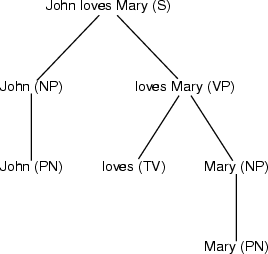3.2.1 A Simple Solution: CFG
We use CFGs as grammar format.
Task 1 
In order to approach Task 1, we have opted for an easy solution: We've decided to use a simple context free grammar. The syntactic analysis of a sentence will be represented as a tree whose non-leaf nodes represent complex syntactic categories (such as S, NP and VP) and whose leaves represent lexical items (these are associated with lexical categories such as noun, transitive verb, determiner, proper name and intransitive verb). Recall (the syntactic part of) the tree tasks from Section 3.1.4:

This tree model tells us that ``John loves Mary'' is an S (sentence) that is composed of the subject NP (noun phrase) ``John'' and the VP (verb phrase) ``loves Mary'', which in turn consists of the TV (transitive verb) ``loves'' and the NP ``Mary'', which is made of the PN ``Mary'', and so on. To enhance the readability of such trees, we will ommit the non-branching steps and take for instance  as a leave node.
as a leave node.
Our approach to syntactic structure is not very elaborate. There are many interesting syntactic phenomena it won't allow us to describe. Hence, the approach won't take us far in terms of coverage of our grammar. But it has one important advantage: It enables us to make use of Definite Clause Grammars (DCGs, Lecture 7 of Learn Prolog Now!)) DCG, the in-built Prolog mechanism for grammar specification.